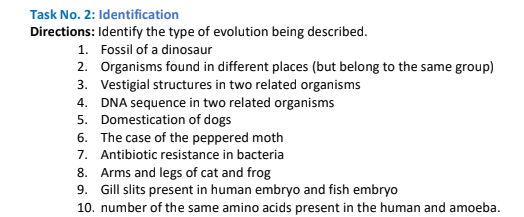Task No. 2: Identification Directions: Identify the type of evolution being described. 1. Fossil of a dinosaur 2. Organisms found in different places (but belong to the same group) 3. Vestigial structures in two related organisms 4. DNA sequence in two related organisms 5. Domestication of dogs 6. The case of the peppered moth 7. Antibiotic resistance in bacteria 8. Arms and legs of cat and frog 9. Gill slits present in human embryo and fish embryo 10. number of the same amino acids present in the human and amoeba.
Task No. 2: Identification Directions: Identify the type of evolution being described. 1. Fossil of a dinosaur 2. Organisms found in different places (but belong to the same group) 3. Vestigial structures in two related organisms 4. DNA sequence in two related organisms 5. Domestication of dogs 6. The case of the peppered moth 7. Antibiotic resistance in bacteria 8. Arms and legs of cat and frog 9. Gill slits present in human embryo and fish embryo 10. number of the same amino acids present in the human and amoeba.
Biology: The Dynamic Science (MindTap Course List)
4th Edition
ISBN:9781305389892
Author:Peter J. Russell, Paul E. Hertz, Beverly McMillan
Publisher:Peter J. Russell, Paul E. Hertz, Beverly McMillan
Chapter24: Systematics And Phylogenetics: Revealing The Tree Of Life
Section: Chapter Questions
Problem 10TYK: To construct a phylogenetic tree by applying the principles of parsimony to molecular sequence data,...
Related questions
Question
100%
Identify the type of evolution being described.

Transcribed Image Text:Task No. 2: Identification
Directions: Identify the type of evolution being described.
1. Fossil of a dinosaur
2. Organisms found in different places (but belong to the same group)
3. Vestigial structures in two related organisms
4. DNA sequence in two related organisms
5. Domestication of dogs
6. The case of the peppered moth
7. Antibiotic resistance in bacteria
8. Arms and legs of cat and frog
9. Gill slits present in human embryo and fish embryo
10. number of the same amino acids present in the human and amoeba.
Expert Solution
This question has been solved!
Explore an expertly crafted, step-by-step solution for a thorough understanding of key concepts.
Step by step
Solved in 3 steps

Knowledge Booster
Learn more about
Need a deep-dive on the concept behind this application? Look no further. Learn more about this topic, biology and related others by exploring similar questions and additional content below.Recommended textbooks for you

Biology: The Dynamic Science (MindTap Course List)
Biology
ISBN:
9781305389892
Author:
Peter J. Russell, Paul E. Hertz, Beverly McMillan
Publisher:
Cengage Learning

Biology 2e
Biology
ISBN:
9781947172517
Author:
Matthew Douglas, Jung Choi, Mary Ann Clark
Publisher:
OpenStax

Biology: The Dynamic Science (MindTap Course List)
Biology
ISBN:
9781305389892
Author:
Peter J. Russell, Paul E. Hertz, Beverly McMillan
Publisher:
Cengage Learning

Biology 2e
Biology
ISBN:
9781947172517
Author:
Matthew Douglas, Jung Choi, Mary Ann Clark
Publisher:
OpenStax